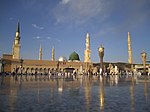Mount Uhud
This article needs additional citations for verification. (March 2007) |
| Mount Uhud | |
|---|---|
 | |
| Highest point | |
| Coordinates | 24°30′37″N 039°36′50″E / 24.51028°N 39.61389°E |
| Geography | |
| Location | Medina, Saudi Arabia |
| Province | Al Madinah Region |
Mount Uhud (Arabic: جَبَل أُحُد, romanized: Jabal Uḥud) is a mountain north of Medina, Saudi Arabia. It is 1,077 m (3,533 ft) high and 7.5 km long. It was the site of the second battle between Muslim and unbelievers. The Battle of Uhud was fought on 19 March, 625 CE, between a force from the small Muslim community of Medina, in what is now north-western Arabia, and a force from Mecca.

Battle of Uhud[]
The battle was fought on March 19, 625 CE (3 Shawwal 3 AH in the Islamic calendar) at the valley located in front of Mount Uhud, in what is now northwestern Arabia.[1] It occurred between a force from the Muslim community of Medina led by the Islamic prophet Muhammad, and a force led by Abu Sufyan ibn Harb from Mecca, the town from which many of the Muslims had previously emigrated. The Battle of ‘Uḥud was the second military encounter between the Meccans and the Muslims, preceded by the Battle of Badr in 624 CE, where a small Muslim army had defeated the much larger Meccan army.
Marching out from Mecca towards Medina on March 11, 625 CE, the Meccans desired to avenge their losses at Badr and strike back at Muhammad and his followers. The Muslims readied for war soon afterward and the two armies fought on the slopes and plains of Mount ‘Uḥud.
Whilst heavily outnumbered, the Muslims gained the early initiative and forced the Meccan lines back, thus leaving much of the Meccan camp unprotected. When the battle looked to be only one step far from a decisive Muslim victory, a serious mistake was committed by a part of the Muslim army, which shifted the outcome of the battle. A breach of Muhammad's orders by the Muslim archers, who left their assigned posts to despoil the Meccan camp, allowed a surprise attack from the Meccan cavalry, led by Meccan war veteran Khalid ibn al-Walid, which brought chaos to the Muslim ranks. Many Muslims were killed, including Hamza ibn ‘Abd al-Muttalib, Muhammad's uncle and foster brother. Muhammad himself got injured. The Muslims had to withdraw up the slopes of ‘Uḥud. The Meccans did not pursue the Muslims further, but marched back to Mecca declaring victory. The two armies would meet again in 627 CE at the Battle of the Trench.[2]

See also[]
- Battle of Badr
- List of battles of Muhammad
References[]
Coordinates: 24°30′37″N 039°36′50″E / 24.51028°N 39.61389°E
- Mountains of Saudi Arabia
- Burial sites of the Senussi dynasty
- Saudi Arabia geography stubs






